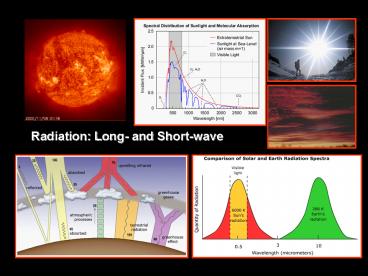Radiation: Long and Shortwave - PowerPoint PPT Presentation
1 / 14
Title:
Radiation: Long and Shortwave
Description:
where ? = azimuth angle between sun and surface normal; = surface angle of tilt ... as, s - solar azimuth and. elevation respectively. Internal long-wave radiation ... – PowerPoint PPT presentation
Number of Views:259
Avg rating:3.0/5.0
Title: Radiation: Long and Shortwave
1
Radiation Long- and Short-wave
2
Short-wave Radiation
3
The Sun
- Core temperature 8x106 to 40x106 K.
- Effective black body temperature is 6000 K.
- Solar constant extraterrestrial flux from the
sun received on a unit area perpendicular to the
direction of propagation mean Sun/Earth
distance value is 1353 W/m2. - Actual extraterrestial radiation varies with time
of year as earth-sun distance varies.
4
Sun position
5
Solar time
ts tm ldiff/15 et ds where, ts solar
time tm local time ldiff longitude
difference to the standard meridian et equation
of time ds daylight saving time (e.g. British
summer time)
known
Idh - direct radiation on the horizontal
(W/m2) Ifh - diffuse radiation on the horizontal
(W/m2) ITh - total radiation on the horizontal
(Idh Ifh) rg - ground reflectivity Idß -
direct radiation on a surface of inclination ßf
(W/m2) Isß - sky diffuse radiation incident on a
surface of inclination ßf (W/m2) Irß - ground
reflected radiation incident on a surface of
inclination ßf (W/m2)
unknown
6
Solar geometry
- Declination
- d 23.45 sin (280.1 0.9863 Y)
- where Y year day number (January 1 1,
- December 31 365)
- Altitude
- a sin-1 cos L cos d cos ?h sin L sin d
- where L is site latitude
- ?h is hour angle 15 (12 ts)
- Azimuth
- z sin-1 cos d sin ?h / cos a
- Incidence angle
- iß cos-1 sin a cos (90-ß) cos a cos ? sin
(90-ß) - where ? azimuth angle between sun and surface
normal - ß surface angle of tilt
7
Spectral distribution
NASA/ASTM Standard Spectral Irradiance
8
Atmospheric interactions
- The greater the distance that the radiation
passes through the atmosphere, the greater is the
frequency dependent scattering. Spectra at ground
level are often referred to particular air
masses. - Air Mass 1 is the thickness of the atmosphere
vertically above sea level. - Air Mass 2 is double this thickness (equivalent
to direct solar radiation at an altitude of 30
degrees).
9
Short-wave radiation flow-paths
A - reflected shortwave flux B - flux emission by
convection and longwave radiation C -
shortwave flux transmission to cause opaque
surface insolation D - shortwave transmission to
cause transparent surface insolation E -
shortwave transmission to adjacent zone F -
enclosure reflections G - shortwave loss H -
solar energy penetration by transient
conduction I - solar energy absorption prior to
retransmission by the processes of B.
10
Short-wave radiation - calculation
iß - angle between the incident
beam and the surface normal vector ? -
surface-solar azimuth ( as -
af) af, ßf - surface azimuth and
elevation respectively as, ßs - solar azimuth and
elevation respectively
- Intensity of direct radiation on surface of
inclination ß - Idß Idn cos iß / sin ßs
- Intensity of diffuse radiation on same surface
- ground reflected Irß 0.5 1- cos (90 ßf)
(Idh Ifh ) rg -
where rg is the ground reflectance - sky component Isß 0.5 1 cos (90 - ßf)
Ifh - assuming an
isotropic diffuse sky - In practice the sky is not isotropic and so
empirically-based models that correct for
circumsolar and horizon brightening are employed - sky component
- Angle of incidence
11
Internal long-wave radiation
12
Internal long-wave radiation calculation
13
Internal long-wave radiation view factors
14
External long-wave radiation































